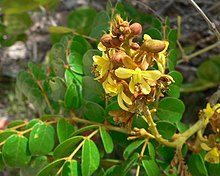Guilandina bonduc
| Guilandina bonduc | |
|---|---|

| |
| Scientific classification | |
| Kingdom: | Plantae |
| Clade: | Tracheophytes |
| Clade: | Angiosperms |
| Clade: | Eudicots |
| Clade: | Rosids |
| Order: | Fabales |
| Family: | Fabaceae |
| Subfamily: | Caesalpinioideae |
| Genus: | Guilandina |
| Species: | G. bonduc
|
| Binomial name | |
| Guilandina bonduc | |
| Synonyms[2] | |
| |
Guilandina bonduc, commonly known as grey nicker, nicker bean,[3] fever nut[4] or knicker nut, is a species of flowering plant in the senna tribe, Caesalpinieae,[2] that has a pantropical distribution.[5]
Description
[edit]
It is a liana that reaches a length of 6 m (20 ft) or more and scrambles over other vegetation. The stems are covered in curved spines.[6]
Guilandina bonduc grows as a climber, up to 8 m (30 ft) long or as a large sprawling shrub or small shrubby tree. The stems are irregularly covered with curved prickles. The leaves are large and bi-pinnate, up to 40 cm (16 in) long with scattered prickles on the rachises and blades. There are four to eleven pairs of pinnae, 5 to 20 cm (2 to 8 in) long with five to ten pairs of pinnules. The pinnules are 15 to 40 mm (0.6 to 1.6 in) long, elliptic, oblong or ovate with acute tips and entire margins.[3][7][8]
The inflorescence is an axillary raceme, often branched, covered with short hairs and up to 15 cm (6 in) long. The jointed pedicels are up to 6 mm (0.2 in) long. The sepals are shorter than the petals which are around 10 mm (0.4 in) long; the petals are yellow, sometimes with a spot of orange near the base of the keel. The unisexual flowers are followed by large, flattish, spiny green pods which later turn brown, some 9 by 4 cm (4 by 2 in), containing one or usually two, glossy, rounded, grey seeds.[3][7][8]

Its 2 cm (0.8 in) grey seeds,[9] known as nickernuts,[10] are buoyant and durable enough to be dispersed by ocean currents.[5]
Distribution and habitat
[edit]Guilandina bonduc has a pantropical distribution. It typically grows near the coast, in scrub, on sand dunes and on the upper shore.[11] It also occurs inland, in lowland secondary forest and disturbed areas near villages; this may be the result of the seed being accidentally dropped after being transported for medical purposes or for use as counters in board games. The seeds are buoyant and retain their viability in both fresh and sea water, enabling them to disperse to new coastal locations.[12] When washed up on the shore, they are sometimes known as sea pearls.[13]
Uses
[edit]Nodules on the plant's roots contain symbiotic bacteria that fix nitrogen. This is used as a nutrient by the vine and also benefits other plants growing in close proximity.[12] It is a popular local ornamental plant in Malaysia.[14]
This plant has been used in traditional medicine. The seeds have tonic and antipyretic properties and the bark and leaves have been used likewise. The root can be pounded to remedy caterpillar stings, it can be boiled ans its broth drank to regulate menstruation.[15]: 196 An oil extracted from the seeds has been used in cosmetics and for treating discharges from the ear.[4]
Tongans make the hard seeds (talatala ‘amoa) into leis or play with them like marbles; its spiky leaves and stems are used in fruit bat snares.[8]
References
[edit]- ^ Bachman, S. (2018). "Guilandina bonduc". IUCN Red List of Threatened Species. 2018: e.T65899567A122396032. doi:10.2305/IUCN.UK.2018-2.RLTS.T65899567A122396032.en. Retrieved 11 December 2022.
- ^ a b "Caesalpinia bonduc". Germplasm Resources Information Network. Agricultural Research Service, United States Department of Agriculture. Retrieved 2010-12-06.
- ^ a b c Caesalpinia bonduc PlantNet: Royal Botanic Garden, Sydney. Accessed 15 March 2018.
- ^ a b "Fever nut". Flowers of India. Retrieved 12 September 2020.
- ^ a b Cody, Martin L. (2006). Plants on Islands: Diversity and Dynamics on a Continental Archipelago. University of California Press. p. 161. ISBN 978-0-520-24729-1.
- ^ Oudhia, P., 2007. Caesalpinia bonduc (L.) Roxb. [Internet] Record from PROTA4U. Schmelzer, G.H. & Gurib-Fakim, A. (Editors). PROTA (Plant Resources of Tropical Africa / Ressources végétales de l’Afrique tropicale), Wageningen, Netherlands.
- ^ a b "Guilandina bonduc". Native Plants: Hawaii. Retrieved 11 September 2020.
- ^ a b c Whistler, Art (2011). The Rare Plants of Tonga (PDF). Tonga Trust Ltd. pp. 89–90.
- ^ Nelson, Gil (1996). The Shrubs and Woody Vines of Florida: a Reference and Field Guide. Pineapple Press Inc. pp. 177–178. ISBN 978-1-56164-110-9.
- ^ "Gray Nickarbean or Sea Pearl Caesalpinia bonduc". A Seabean Guide. seabean.com. Retrieved 2010-12-07.
- ^ "Guilandina bonduc L." Flora of Mozambique. Retrieved 12 September 2020.
- ^ a b Fern, Ken. "Guilandina bonduc". Useful tropical plants. Retrieved 12 September 2020.
- ^ "Gray Nickarbean or Sea Pearl". A Sea-Bean Guide. Archived from the original on 25 December 2008. Retrieved 12 September 2020.
- ^ Lee Shin Shin; Aziah Muhamad; Joanne Tong (2015). Mangrove Guidebook for Malaysia. Petaling Jaya, Selangor, Malaysia: Wetlands International, Malaysia. p. 85. ISBN 978-983-42276-6-1.
- ^ Burkill, Isaac Henry; Mohamad Haniff (April 1930). "Malay Village Medicine: prescriptions collected by I.H. Burkill and Mohamad Haniff". The Gardens' Bulletin; Straits Settlements. 6 (3 (part 2)): 165–273.
External links
[edit] Media related to Guilandina bonduc at Wikimedia Commons
Media related to Guilandina bonduc at Wikimedia Commons Data related to Guilandina bonduc at Wikispecies
Data related to Guilandina bonduc at Wikispecies- Dressler, S.; Schmidt, M. & Zizka, G. (2014). "Caesalpinia bonduc". African plants – a Photo Guide. Frankfurt/Main: Forschungsinstitut Senckenberg.

